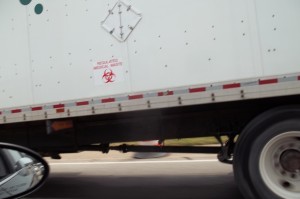The regulations of the PHMSA/USDOT at 49 CFR 173.134 contain the definitions and exceptions applicable to Division 6.2 Infectious Substances as they are regulated when in transportation or offered for transportation. In an earlier article I attempted to explain how the transportation of a Regulated Medical Waste fits in this rather complicated regulation (read: The Identification and Transportation of a Regulated Medical Waste). In that article I referenced but did not identify the exceptions to regulation as a Division 6.2 Infectious Substance for certain materials and articles. The purpose of this article is to identify and explain (if necessary) those materials that are not subject to the Hazardous Material Regulations as Division 6.2 Infectious Substances.

49 CFR 173.134(b) reads:
(b) Exceptions. The following are not subject to the requirements of this subchapter as Division 6.2 materials:
A few notes before we begin the list:
- “…this subchapter…” means Subchapter C of Title 49 of the Code of Federal Regulations (CFR): The Hazardous Material Regulations of the PHMSA/USDOT. This means it is not subject to any regulations of the PHMSA/USDOT as a HazMat when in transportation or offered for transportation.
- However, “…as Division 6.2 materials” limits the exception to just the HMR applicable to an Infectious Substance (Division 6.2). If the material is a hazardous material per the HMR for some other reason, eg. Corrosive (Class 8), Flammable (Class 3), &etc., then it will remain subject to the HMR for those hazards.
- Several terms used in this list of excepted materials, and throughout 49 CFR 173.134, are deliberately vague; such as: “…unlikely to cause disease…” or “…non-infectious biological materials…” or “…neutralized or inactivated…” and many more. The PHMSA/USDOT presumes that anyone offering for transportation a material of this nature will be able to make this determination. As the Shipper your classification of what is a HazMat and what is not, and whether or not an exception from regulation is applicable is solely your responsibility.
- For definitions of terms such as “Pathogen”, “Infectious Substance”, and more, refer to 49 CFR 173.134 or my article: The Identification and Transportation of a Regulated Medical Waste.
- Text from the exception has been edited for brevity and clarification. Emphasis have been added.
- And finally, this is a summary of the regulations, make certain to review 49 CFR 173.134 in its entirety to confirm your responsibility as a Shipper.

The list of exceptions to Division 6.2 (Infectious Substances):
(1) A material that does not contain an infectious substance or that is unlikely to cause disease in humans or animals.
(2) Non-infectious biological materials from humans, animals, or plants. Examples include:
- Non-infectious cells
- Tissue cultures
- Blood or plasma from individuals not suspected of having an infectious disease
- DNA, RNA or other non-infectious genetic elements.
(3) A material containing micro-organisms that are non-pathogenic to humans or animals.
(4) A material containing pathogens that have been neutralized or inactivated such that they no longer pose a health risk.
(5) A material with a low probability of containing an infectious substance, or where the concentration of the infectious substance is at a level naturally occurring in the environment so it cannot cause disease when exposure to it occurs. Examples of these materials include:
- Foodstuffs
- Environmental samples, such as water or a sample of dust or mold; and,
- Substances that have been treated so that the pathogens have been neutralized or deactivated, such as a material treated by steam sterilization, chemical disinfection, or other appropriate method, so it no longer meets the definition of an infectious substance.
(6) A biological product [defined at 49 CFR 173.134(a)(2)], including an experimental or investigational product or component of a product, subject to Federal approval, permit, review, or licensing requirements, such as those required by the Food and Drug Administration of the U.S. Department of Health and Human Services or the U.S. Department of Agriculture.
(7) The following:
- Blood collected for the purpose of blood transfusion or the preparation of blood products

Under certain conditions blood is excepted from regulation as a Division 6.2 Infectious Substance - Blood products
- Plasma and plasma derivatives
- Blood components
- Tissues or organs intended for use in transplant operations
- Human cell, tissues, and cellular and tissue-based products regulated under authority of the Public Health Service Act (42 U.S.C. 264-272) and/or the Food, Drug, and Cosmetic Act (21 U.S.C. 332 et seq.).
(8) Blood, blood plasma, and blood components collected for the purpose of blood transfusion or the preparation of blood products and sent for testing as part of the collection process, except where the person collecting the blood has reason to believe it contains an infectious substance, in which case the test sample must be shipped as a Category A or Category B infectious substance in accordance with §173.196 or §173.199, as appropriate.
(9) Dried blood spots or specimens for fecal occult blood detection placed on absorbent filter paper or other material.
(10) Either of the following if transported by a private or contract carrier in a motor vehicle used exclusively to transport such materials:
- A Division 6.2 material, other than a Category A infectious substance, (which means it must be a Category B Infectious Substance) and contained in a patient sample being transported for research, diagnosis, investigational activities, or disease treatment or prevention.
Or…
- A biological product [defined at 49 CFR 173.134(a)(2)].
Medical or clinical equipment and laboratory products may be transported aboard the same vehicle as the human or animal sample or biological product provided they are properly packaged and secured against exposure or contamination.
If the human or animal sample or biological product meets the definition of regulated medical waste in 49 CFR 173.134(a)(5), it must be offered for transportation and transported in conformance with the appropriate requirements for regulated medical waste (refer to my article: The Identification and Transportation of a Regulated Medical Waste).
(11) A human or animal sample being transported for routine testing not related to the diagnosis of an infectious disease, such as for drug/alcohol testing, cholesterol testing, blood glucose level testing, prostate specific antibody testing, testing to monitor kidney or liver function, or pregnancy testing, or for tests for diagnosis of non-infectious diseases, such as cancer biopsies, and for which there is a low probability the sample is infectious. Includes:
- Secreta
- Excreta
- Blood and its components
- Tissue and tissue fluids
- Body parts
(12) Laundry and medical equipment and used health care products (ie. a health care product that has been removed from its original packaging), as follows:

- Laundry or medical equipment conforming to the regulations of the Occupational Safety and Health Administration of the Department of Labor in 29 CFR 1910.1030 (OSHA’s Bloodborne Pathogen Rule). This exception includes medical equipment intended for use, cleaning, or refurbishment, such as reusable surgical equipment, or equipment used for testing where the components within which the equipment is contained essentially function as packaging. This exception does not apply to medical equipment being transported for disposal.
- Used health care products not conforming to the requirements in 29 CFR 1910.1030 (OSHA’s Bloodborne Pathogen Rule) and being returned to the manufacturer or the manufacturer’s designee when offered for transportation or transported in accordance with (A) through (D) of this paragraph (read on). Used health care products contaminated with or suspected of contamination with a Category A infectious substance may not be transported under the provisions of this paragraph.
- (A) Each used health care product must be drained of free liquid to the extent practicable and placed in a watertight primary container designed and constructed to assure that it remains intact under conditions normally incident to transportation. For a used health care product capable of cutting or penetrating skin or packaging material (eg. Sharps), the primary container must be capable of retaining the product without puncture of the packaging under normal conditions of transport. Each primary container must be marked with a BIOHAZARD marking conforming to 29 CFR 1910.1030(g)(1)(i) of the OSHA regulations.
- (B) Each primary container must be placed inside a watertight secondary container designed and constructed to assure that it remains intact under conditions normally incident to transportation. The secondary container must be marked with a BIOHAZARD marking conforming to 29 CFR 1910.1030(g)(1)(i) of the OSHA regulations.
- (C) The secondary container must be placed inside an outer packaging with sufficient cushioning material to prevent movement between the secondary container and the outer packaging. An itemized list of the contents of the primary container and information concerning possible contamination with a Division 6.2 material, including its possible location on the product, must be placed between the secondary container and the outside packaging.
- (D) Each person who offers or transports a used health care product under the provisions of this paragraph must know about the requirements of this paragraph. But not, necessarily, require HazMat Employee training pursuant to 49 CFR 172, Subpart H.
(13) Any waste or recyclable material, other than regulated medical waste, including:
- Household waste as defined in §171.8, when transported in accordance with applicable state, local, or tribal requirements.
- Sanitary waste or sewage
- Sewage sludge or compost
- Animal waste generated in animal husbandry or food production
- Medical waste generated from households and transported in accordance with applicable state, local, or tribal requirements.
(14) Corpses, remains, and anatomical parts intended for interment, cremation, or medical research at a college, hospital, or laboratory.
(15) Forensic material transported on behalf of a U.S. Government, state, local or Indian tribal government agency. This exception does not include:
- Forensic material known or suspected to contain a Category B infectious substance. These must be shipped in a packaging conforming to the provisions of §173.24.
- Forensic material known or suspected to contain a Category A infectious substance or an infectious substance listed as a select agent in 42 CFR Part 73. These must be transported in packaging capable of meeting the test standards in §178.609 of the HMR. The secondary packaging must be marked with a BIOHAZARD symbol conforming to specifications in 29 CFR 1910.1030(g)(1)(i) (OSHA’s Bloodborne Pathogen Rule). An itemized list of contents must be enclosed between the secondary packaging and the outer packaging.
(16) Agricultural products and food as defined in the Federal Food, Drug, and Cosmetics Act (21 U.S.C. 332 et seq.).
That’s still not all the exceptions from regulation as a Division 6.2 Infectious Substance available; one more is found at 49 CFR 173.134(c) specifically for Regulated Medical Waste. You can read more about that exception in my earlier article: The Identification and Transportation of a Regulated Medical Waste.
Daniels Training Services 815.821.1550 |
If you are required to ship a Division 6.2 Infectious Substance (Category A or B) and you are not able to utilize the exceptions from regulation at 49 CFR 173.134(b) or (c), then it must be shipped in full compliance with the Hazardous Materials Regulations of the PHMSA/USDOT. Contact me with questions about the transportation of hazardous materials or to schedule HazMat Employee training to ensure your regulatory compliance.

